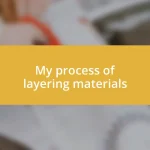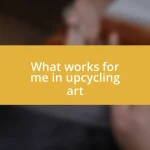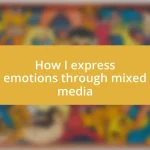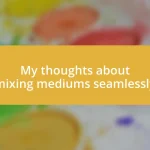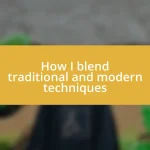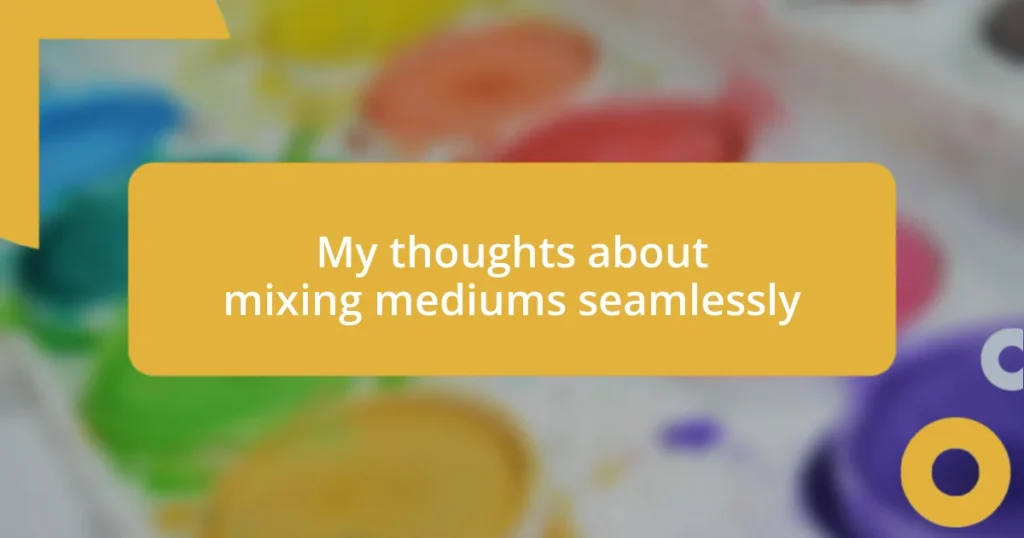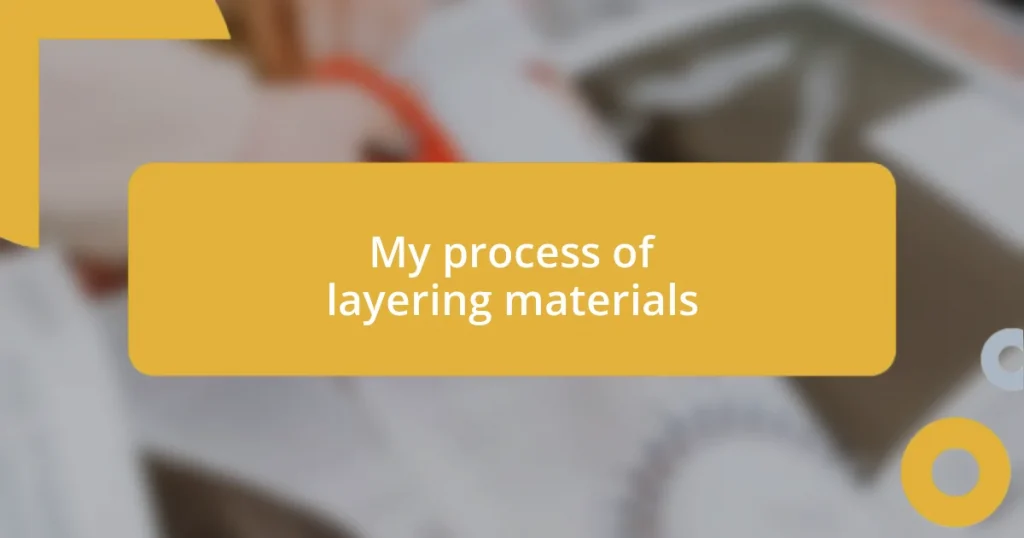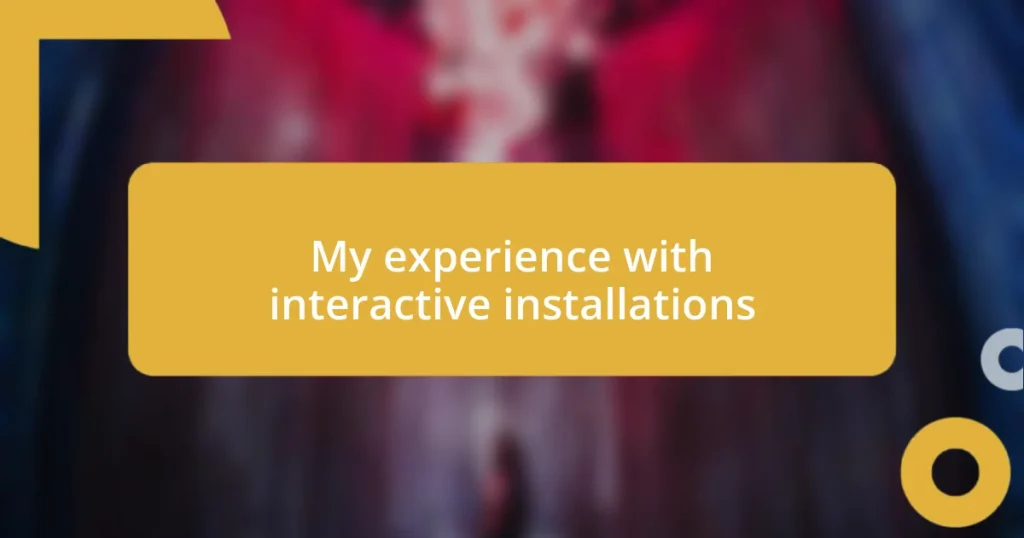Key takeaways:
- Mixing mediums enhances artistic expression, allowing for unexpected discoveries and richer visual narratives.
- Choosing the right mediums involves considering compatibility, desired effects, personal comfort, and the overall theme of the artwork.
- Avoid common mistakes by testing compatibility and trusting instincts rather than overthinking mixing ratios for spontaneous creativity.

Understanding mixing mediums
Mixing mediums is like creating a bespoke recipe; you need to know how different elements react together. I remember when I first tried combining acrylics and watercolors—that was both exhilarating and frustrating! The way the colors bled and blended taught me so much about the importance of understanding the properties of each medium. Have you ever experimented in such a way?
It’s fascinating to see how mediums can complement or clash with one another. For instance, using charcoal alongside pastels can create incredible depth and contrast, but you need to apply them thoughtfully. I discovered this during one of my workshops when a fellow artist demonstrated how layering these materials could enhance texture. That moment really opened my eyes to the potential of mixing.
Ultimately, understanding mixing mediums isn’t just about technique; it’s also about intuition and creativity. Sometimes, it feels like a dance—finding the right rhythm between the mediums. Have you tried just playing around without a defined outcome? Those moments often lead to some of the most rewarding discoveries. It’s all about embracing the unexpected!

Benefits of mixing mediums
Mixing mediums brings a wealth of benefits that can significantly enhance your artwork. For instance, when I first blended oils and acrylics, I was astounded by how the textures transformed. The oils created a glossy finish that contrasted beautifully with the matte quality of the acrylics. This layering not only deepened the visual interest but also allowed me to explore new techniques that I hadn’t considered before. Have you ever felt that thrill of discovery in your own work?
Another advantage is the freedom to express oneself without limitations. I recall creating a piece that incorporated digital art, watercolor, and ink. It was freeing to let go of traditional boundaries and allow each medium to contribute to the final piece. Each layer told a different story, and the mixed media approach added richness that I couldn’t have achieved with a single medium alone. It felt like inviting my creativity to run wild!
Lastly, mixing mediums fosters innovation. Every combination presents a chance to stumble upon unexpected effects, much like the time I mixed metallic paints with watercolor. The shimmering finish caught the light beautifully, creating a depth that surprised even me. This experimentation not only breathed new life into my work but also challenged my artistic boundaries, which I find incredibly rewarding. Have you discovered something new by mixing mediums?
| Benefit | Description |
|---|---|
| Enhanced Visual Interest | Different textures and finishes create a dynamic look. |
| Freedom of Expression | Combining mediums allows for a more personal and diverse artistic voice. |
| Innovation | Mixing encourages creativity and discovering new techniques and effects. |

Choosing the right mediums
Choosing the right mediums for your project can feel a bit like being a chef—it’s all about balance and flavor! I’ve often found myself standing in front of my supplies, contemplating which mediums might play well together. For instance, when I opted to pair gouache with ink, the results were surprisingly vibrant, almost like bringing two personalities together to create something unique. The right combination can not only elevate your artistic expression but also lead you to discoveries that surprise and delight.
- Consider the following factors when selecting mediums:
- Compatibility: Ensure that the mediums will interact positively. For example, oil paint and acrylic have different drying times and properties.
- Desired Effect: Think about what you want to achieve—textured layers, transparency, or bold colors.
- Personal Comfort: Choose mediums that you enjoy working with; your enthusiasm can enhance the final outcome.
- Experience Level: If you’re a beginner, start with familiar mediums before experimenting with more complex combinations.
- Theme and Message: The story you want to tell can guide your choices, making some mediums feel more relevant to your vision than others.
In my experience, experimenting with various mediums has often led to unexpected personal moments. I remember once during a late-night session, I casually tried adding a layer of coffee to my painting, thinking it might just give texture. Instead, it ended up adding a warm, rich hue that turned my artwork into something I never envisioned. That little risk felt like a breath of fresh air—and it reminded me that sometimes the best pathways in art come from simply choosing to explore.

Techniques for seamless mixing
When it comes to mixing mediums, one technique I find incredibly effective is layering. Starting with a base of one medium and allowing it to dry before applying the next can create stunning contrasts. I remember a project where I layered watercolor beneath acrylics; watching the colors interact was like witnessing a dance transform into a symphony. Doesn’t it feel magical when you see two mediums harmonize in such an unexpected way?
Another approach I cherish is using a palette knife to blend. This technique is especially captivating with thick mediums like oil or impasto acrylics. I once created a sunrise scene using this method, pushing different colors together on the canvas. The texture and vibrancy that emerged felt like it was alive, pulsating with energy. Have you ever tried a similar technique? The tactile experience can really deepen your connection to the artwork, adding a visceral quality that can be quite powerful.
Finally, don’t underestimate the power of mixing on your palette before it ever touches the canvas. I often experiment with color combinations there, playing with ratios and textures until I find a blend that excites me. Recently, I tried mixing a metallic gold with a transparent glaze and was amazed at how it transformed into a luminous wash. Sometimes the best surprises come from spending time at your workspace just playing with colors—how often do you allow yourself that exploration? Each discovery is a step toward refining your own unique artistic voice.

Common mistakes to avoid
It’s easy to rush into mixing mediums without considering their unique characteristics, and that can lead to disappointment. I once blended acrylics with watercolors for a detailed project, hoping to achieve a soft transition, only to learn the hard way how quickly acrylics can overpower watercolors. Have you ever experienced a similar bungled mix? The result can be a muddy mess rather than the dreamy wash you envisioned.
Another common mistake I’ve noticed is neglecting to test compatibility before a big project. In one of my earliest attempts, I jumped into a large canvas with oil pastels and acrylics, confident they would mesh beautifully. Instead, I ended up battling a slick surface that refused to hold my paint. Taking a moment to do some smaller tests beforehand could save a lot of heartache and time down the line.
Finally, there’s the tendency to overthink the mixing ratios. Yes, I’ve definitely fallen into that trap—like the time I meticulously measured each drop of medium in a big effort to perfect my color. Yet, what if I had simply trusted my instincts and let the colors dance together? The beauty of art lies in its spontaneity, so don’t be shy about experimenting! What’s the worst that could happen? You might just stumble upon something spectacular!

Practical applications of mixed media
One of the most enchanting applications of mixed media I’ve experienced is in collage art. I distinctly remember a project where I combined vintage paper scraps with vibrant acrylic paints to create a whimsical landscape. Each piece seemed to bring its own story, adding depth and character to the composition. Have you ever felt that thrill of discovery when contrasting items come together to form something entirely new? It’s a reminder that art is not just about visuals; it’s about storytelling.
Another practical application I adore involves using mixed media in journal art. Incorporating everything from fabric to lettering alongside watercolor and ink can turn an ordinary journal page into a vibrant visual narrative. I often find myself layering photographs and sketches, capturing moments of my life in a way that’s both expressive and deeply personal. How do you express your feelings through your art? Each splash of color or textured layer captures emotions that words sometimes can’t convey.
Lastly, I’ve found that using mixed media in home decor can elevate a space beautifully. By combining textures like wood, metal, and fabric with paint, I once created an eye-catching wall hanging that not only brought color into my living room but also became a topic of conversation among friends. Isn’t it fascinating how art can transcend traditional boundaries and transform our surroundings? The potential for creativity in everyday life is limitless when we embrace mixed media!

